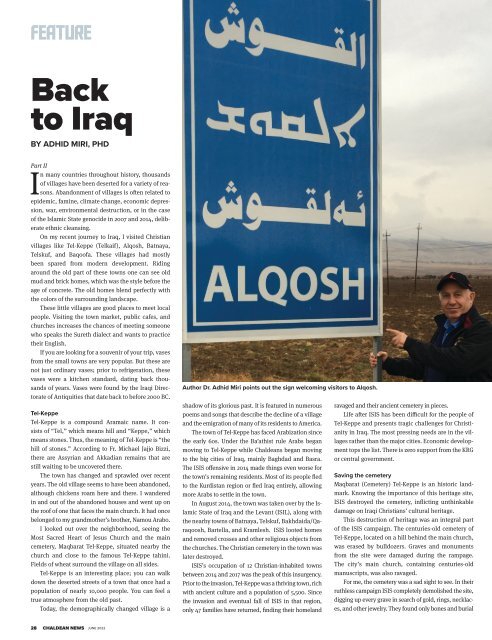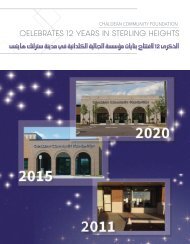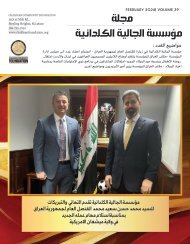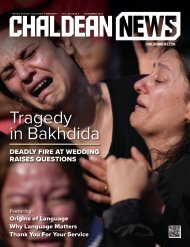Create successful ePaper yourself
Turn your PDF publications into a flip-book with our unique Google optimized e-Paper software.
FEATURE<br />
Back<br />
to Iraq<br />
BY ADHID MIRI, PHD<br />
Part II<br />
In many countries throughout history, thousands<br />
of villages have been deserted for a variety of reasons.<br />
Abandonment of villages is often related to<br />
epidemic, famine, climate change, economic depression,<br />
war, environmental destruction, or in the case<br />
of the Islamic State genocide in 2007 and 2014, deliberate<br />
ethnic cleansing.<br />
On my recent journey to Iraq, I visited Christian<br />
villages like Tel-Keppe (Telkaif), Alqosh, Batnaya,<br />
Telskuf, and Baqoofa. These villages had mostly<br />
been spared from modern development. Riding<br />
around the old part of these towns one can see old<br />
mud and brick homes, which was the style before the<br />
age of concrete. The old homes blend perfectly with<br />
the colors of the surrounding landscape.<br />
These little villages are good places to meet local<br />
people. Visiting the town market, public cafes, and<br />
churches increases the chances of meeting someone<br />
who speaks the Sureth dialect and wants to practice<br />
their English.<br />
If you are looking for a souvenir of your trip, vases<br />
from the small towns are very popular. But these are<br />
not just ordinary vases; prior to refrigeration, these<br />
vases were a kitchen standard, dating back thousands<br />
of years. Vases were found by the Iraqi Directorate<br />
of Antiquities that date back to before 2000 BC.<br />
Tel-Keppe<br />
Tel-Keppe is a compound Aramaic name. It consists<br />
of “Tel,” which means hill and “Keppe,” which<br />
means stones. Thus, the meaning of Tel-Keppe is “the<br />
hill of stones.” According to Fr. Michael Jajjo Bizzi,<br />
there are Assyrian and Akkadian remains that are<br />
still waiting to be uncovered there.<br />
The town has changed and sprawled over recent<br />
years. The old village seems to have been abandoned,<br />
although chickens roam here and there. I wandered<br />
in and out of the abandoned houses and went up on<br />
the roof of one that faces the main church. It had once<br />
belonged to my grandmother’s brother, Namou Arabo.<br />
I looked out over the neighborhood, seeing the<br />
Most Sacred Heart of Jesus Church and the main<br />
cemetery, Maqbarat Tel-Keppe, situated nearby the<br />
church and close to the famous Tel-Keppe tahini.<br />
Fields of wheat surround the village on all sides.<br />
Tel-Keppe is an interesting place; you can walk<br />
down the deserted streets of a town that once had a<br />
population of nearly 10,000 people. You can feel a<br />
true atmosphere from the old past.<br />
Today, the demographically changed village is a<br />
Author Dr. Adhid Miri points out the sign welcoming visitors to Alqosh.<br />
shadow of its glorious past. It is featured in numerous<br />
poems and songs that describe the decline of a village<br />
and the emigration of many of its residents to America.<br />
The town of Tel-Keppe has faced Arabization since<br />
the early 60s. Under the Ba’athist rule Arabs began<br />
moving to Tel-Keppe while Chaldeans began moving<br />
to the big cities of Iraq, mainly Baghdad and Basra.<br />
The ISIS offensive in 2014 made things even worse for<br />
the town’s remaining residents. Most of its people fled<br />
to the Kurdistan region or fled Iraq entirely, allowing<br />
more Arabs to settle in the town.<br />
In August 2014, the town was taken over by the Islamic<br />
State of Iraq and the Levant (ISIL), along with<br />
the nearby towns of Batnaya, Telskuf, Bakhdaida/Qaraqoosh,<br />
Bartella, and Kramlesh. ISIS looted homes<br />
and removed crosses and other religious objects from<br />
the churches. The Christian cemetery in the town was<br />
later destroyed.<br />
ISIS’s occupation of 12 Christian-inhabited towns<br />
between 2014 and 2017 was the peak of this insurgency.<br />
Prior to the invasion, Tel-Keppe was a thriving town, rich<br />
with ancient culture and a population of 5,500. Since<br />
the invasion and eventual fall of ISIS in that region,<br />
only 47 families have returned, finding their homeland<br />
ravaged and their ancient cemetery in pieces.<br />
Life after ISIS has been difficult for the people of<br />
Tel-Keppe and presents tragic challenges for Christianity<br />
in Iraq. The most pressing needs are in the villages<br />
rather than the major cities. Economic development<br />
tops the list. There is zero support from the KRG<br />
or central government.<br />
Saving the cemetery<br />
Maqbarat (Cemetery) Tel-Keppe is an historic landmark.<br />
Knowing the importance of this heritage site,<br />
ISIS destroyed the cemetery, inflicting unthinkable<br />
damage on Iraqi Christians’ cultural heritage.<br />
This destruction of heritage was an integral part<br />
of the ISIS campaign. The centuries-old cemetery of<br />
Tel-Keppe, located on a hill behind the main church,<br />
was erased by bulldozers. Graves and monuments<br />
from the site were damaged during the rampage.<br />
The city’s main church, containing centuries-old<br />
manuscripts, was also ravaged.<br />
For me, the cemetery was a sad sight to see. In their<br />
ruthless campaign ISIS completely demolished the site,<br />
digging up every grave in search of gold, rings, necklaces,<br />
and other jewelry. They found only bones and burial<br />
28 CHALDEAN NEWS <strong>JUNE</strong> <strong>2022</strong>

















